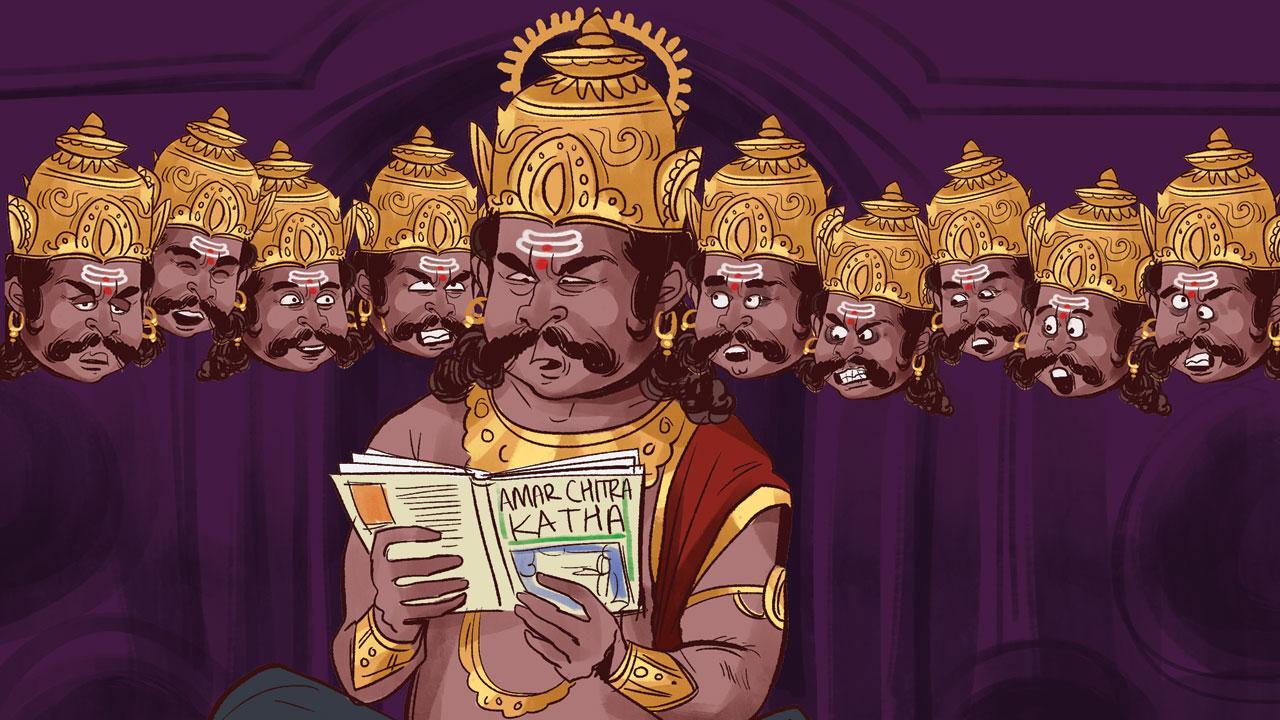For us 70s kids, Indian mythology was learnt from Amar Chitra Katha comics

Illustration/Uday Mohite
 Lord Rama dominated this last week, as all eyeballs were centered on Ayodhya, for the consecration. Amidst the joie de vivre in Mumbai city, motorcycles whizzing by with orange flags attached to the rear, a hologram of Rama reflected on the Sea Link—the Ramayana came back to me. I never got down to reading the Ramayana or the Mahabaratha as books—but for me, both epics dated back to Amar Chitra Katha comics in the seventies, and in my brain they stayed imprinted, as realistic cartoons, as epic tales of valour and vindictiveness, chivalry and chauvinism, skill and sacrifice.
Lord Rama dominated this last week, as all eyeballs were centered on Ayodhya, for the consecration. Amidst the joie de vivre in Mumbai city, motorcycles whizzing by with orange flags attached to the rear, a hologram of Rama reflected on the Sea Link—the Ramayana came back to me. I never got down to reading the Ramayana or the Mahabaratha as books—but for me, both epics dated back to Amar Chitra Katha comics in the seventies, and in my brain they stayed imprinted, as realistic cartoons, as epic tales of valour and vindictiveness, chivalry and chauvinism, skill and sacrifice.
ADVERTISEMENT
For us 70s kids, Indian mythology was learnt from Amar Chitra Katha comics. My stack of Anand Pai’s marvels, alongside my Mad magazine collection, have stood the test of time. Uncle Pai and the good folks at ACK believed in the axiom, “catch ’em young”, and they did—the finely detailed illustrations, our first exposure to religious super-heroes.
The Mahabaratha was my favourite story growing up, the detailed day-by-day waging of war, each book dealing with one specific battle, on Kurukshetra, the main battle ground—the Pandava-Kaurava battle swung one way then the other. Arjuna’s great familial doubts as he saw his cousins on the opposite side, Krishna’s persuasion that he must fight, Karna as a tragic hero, Yudhishtra losing all his kingdoms and wealth in the game of dice, including Draupadi, Duryodhana and co. attempting to disrobe her, and Krishna stepping in as saviour by endlessly extending her sari.
I’m thinking that as an eight year old, the Mahabaratha “captured” me, via the story, though the Ramayana, perhaps, had the more distinct characters—in the former, there was no one clear protagonist, and no definitive antagonist, the two sets of cousins the Pandavas and Kauravas facing off against each other—in the Ramayana, the “hero” of the story, is banished with his wife and brother to the jungles and the “villain” of the story kidnaps the “heroine” and the hero has to save her.
Rama, the clear protagonist had things and events happening to him, but as a child, it was the “evil” antagonist Ravana who was more enthralling—the concept of a demigod, with multi heads, each brain thinking a different thing, but all of them converging on one aim, kidnapping Sita.
Talking about “villains”, has there ever been a more shaded ‘baddie’ than the demon king, the rakhshas Ravana. And his brother Kumbakarna, we talk of an ideal eight hours of sleep, he managed six months, between satisfying his whopping appetite and walloping his enemies in battle, and their sister Surpankaha, incensed that she was rejected in marriage by Rama provoking her brother, Ravana to abduct Sita. All this was magic realism at its best.
Many other characters of the Ramayana, fascinated me as a child, mainly gods who took the form of “animals”—Jatayu, the eagle or vulture, who in his younger reckless days tried to fly towards the sun and nearly got scorched, saved only by his brother who with his giant wings attempted to shield him. But, now older and wiser, Jatayu tries to protect Sita from Ravana, but has a portion of his wing chopped off—as he dies, is able to tell Rama and Lakshman of the kidnapping.
And the greatest character of all, the monkey god Hanuman, loyal to Rama, a fighter to the core, resourceful in the building of the Ram-Setu bridge. And Ravana setting Hanuman’s tail on fire, and parading him around Lanka, but on Sita’s pleading, to Lord Agnideva, made sure that the monkey king was not hurt—and that he shrunk himself in size, to get off his ropes and set fire to Lanka—one of the great “revenge” stories.
Perhaps today is as good a day as any to revisit Amar Chitra Katha comics—I’ll begin with the story of Abhimanyu, son of Arjuna, as he found his way into the Chakravyuh, but unable to retreat, fought armies upon armies, armed only with a chariot wheel.
Rahul daCunha is an adman, theatre director/playwright, photographer and traveller. Reach him at rahul.dacunha@mid-day.com
 Subscribe today by clicking the link and stay updated with the latest news!" Click here!
Subscribe today by clicking the link and stay updated with the latest news!" Click here!







